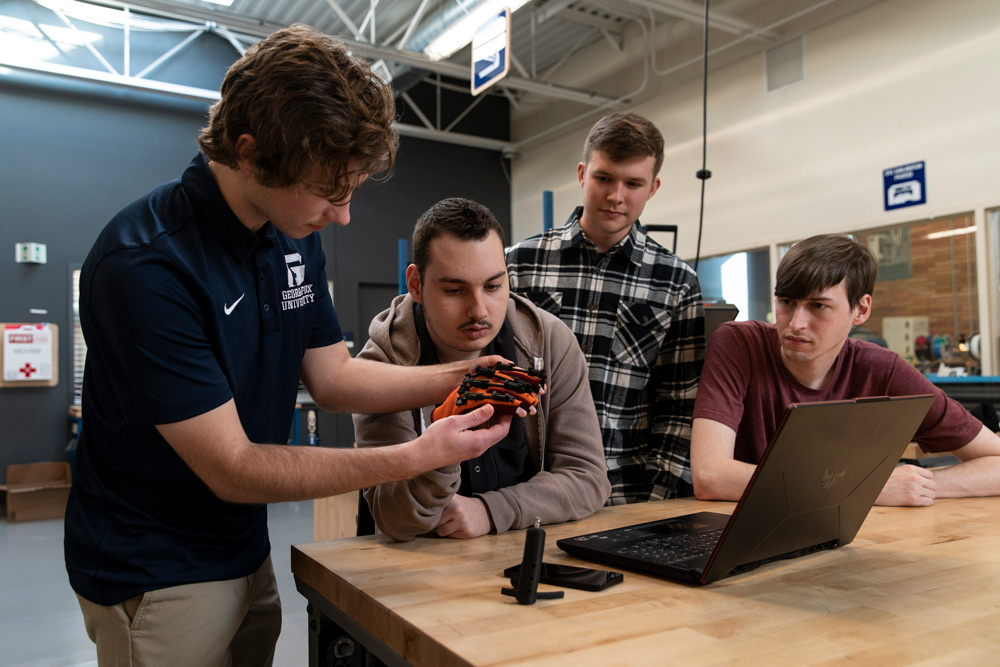PNW Connects Local High School Students with Hands-On Clean Energy Education – Purdue University Northwest

Initiative Overview: Advancing Sustainable Development Through Clean Energy Education
A collaborative initiative has been launched by Purdue University Northwest (PNW) to advance several United Nations Sustainable Development Goals (SDGs) through targeted educational programming. This report details the “Clean Energy and Smart Grids” program, a partnership involving PNW, East Chicago Central High School, and Hammond Central High School. The program is financially supported by a $100,000 “Bridging Our Energy” grant from the NiSource Charitable Foundation and Northern Indiana Public Service Company LLC (NIPSCO), reflecting a multi-stakeholder commitment to sustainable community development.
Core Objectives and Alignment with Sustainable Development Goals (SDGs)
The program is strategically designed to address key global challenges by focusing on education, clean energy, economic growth, and innovation through robust partnerships.
SDG 4: Quality Education
- Providing inclusive and equitable STEM education to high school students and teachers.
- Fostering critical thinking about sustainable energy solutions and their community impact.
- Developing and implementing transferable clean energy curricula for high school classrooms.
SDG 7: Affordable and Clean Energy
- Educating participants on the principles of renewable energy sources, including solar and wind power.
- Introducing advanced concepts such as smart grids, which are digital networks that enhance the reliability and efficiency of electricity distribution.
- Promoting awareness and technical knowledge to support the transition to clean energy systems.
SDG 8: Decent Work and Economic Growth
- Building a skilled talent pipeline to support the region’s growing clean energy sector.
- Promoting greater economic inclusion by providing opportunities for students in local communities.
- Equipping the future workforce with practical, hands-on experience in sustainable technologies.
SDG 17: Partnerships for the Goals
- Demonstrating a successful multi-stakeholder partnership between academia (PNW), the private sector (NiSource, NIPSCO), and local public schools.
- Leveraging corporate social responsibility initiatives to fund and support programs that advance sustainable development at the local level.
Program Implementation and Activities
The initiative employs a dual approach of site-based observation and hands-on laboratory work to provide a comprehensive learning experience. This framework directly supports SDG 9: Industry, Innovation, and Infrastructure by exposing students to modern, resilient energy infrastructure and fostering innovation.
Experiential Learning Framework
Participants will engage in a structured program that combines real-world observation with practical application. This includes:
- Site visits to various energy generation facilities.
- Hands-on activities and research in a university laboratory setting.
Scheduled Site Observations
Field visits are scheduled to provide insight into the operational realities of diverse energy systems.
- Summer 2025 Visits:
- St. Joseph Solar Farm (University of Notre Dame)
- Meadow Lake Wind Farm (Benton and White counties)
- NIPSCO Michigan City Generation Station
- Summer 2026 Visits:
- IND Solar Farm (Indianapolis International Airport)
- Wildcat Wind Farm (Tipton and Madison counties)
- NIPSCO Schahfer Generating Station and Wind Farm (Wheatfield, Indiana)
Laboratory and Curriculum Development
Following site visits, participants will work in PNW’s Smart Grid Design Lab. Under the guidance of Arash Asrari, PNW associate professor of electrical engineering, students will use small-scale electric modules to simulate renewable energy systems and solve real-world challenges. This lab-based work is crucial for reinforcing technical knowledge and co-developing STEM lesson plans that can be integrated into high school curricula, further advancing SDG 4.
Projected Impacts and Future Outlook
The “Clean Energy and Smart Grids” program is positioned to create lasting change by empowering a new generation of leaders focused on sustainable innovation. By integrating education with practical application, the initiative directly contributes to building more sustainable cities and communities (SDG 11) and taking urgent action to combat climate change (SDG 13). The program’s goal is to cultivate a workforce capable of advancing regional energy needs in a responsible and technologically advanced manner, ensuring a resilient and sustainable future for all.
Analysis of SDGs, Targets, and Indicators
1. Which SDGs are addressed or connected to the issues highlighted in the article?
The article discusses a program that connects to several Sustainable Development Goals (SDGs) by focusing on education, clean energy, community development, and partnerships. The following SDGs are addressed:
- SDG 4: Quality Education – The core of the article is the “Clean Energy and Smart Grids program,” an educational initiative for high school students and teachers. It aims to provide “impactful clean energy lessons,” “on-campus learning sessions,” and develop “curricula that can be implemented in high school classrooms.”
- SDG 7: Affordable and Clean Energy – The program’s theme is clean energy. It involves educating students about renewable energy through site visits to solar and wind farms and hands-on activities with modules that “simulate renewable energy systems.” The goal is to promote “resilient, sustainable solutions.”
- SDG 8: Decent Work and Economic Growth – The initiative aims to “build a strong pipeline of skilled talent to support our region’s clean energy future.” By providing students with technical knowledge and hands-on experience, it prepares them for future employment in the growing green economy.
- SDG 11: Sustainable Cities and Communities – The program encourages students to think about the “impact of clean energy in their communities.” The grant supporting the program is designed to “advance local communities” and “promote greater economic inclusion,” contributing to more sustainable community development.
- SDG 17: Partnerships for the Goals – The entire initiative is a multi-stakeholder collaboration. It involves Purdue University Northwest (academia), NiSource Charitable Foundation and NIPSCO (private sector), and two public high schools, demonstrating a partnership to achieve sustainable development objectives.
2. What specific targets under those SDGs can be identified based on the article’s content?
Based on the activities and goals described in the article, the following specific SDG targets can be identified:
- Target 4.4: By 2030, substantially increase the number of youth and adults who have relevant skills, including technical and vocational skills, for employment, decent jobs and entrepreneurship.
- Explanation: The article states the program helps participants “gain valuable hands-on experience” and “reinforce technical knowledge in renewable energy” to “build a strong pipeline of skilled talent.” This directly aligns with providing youth with relevant technical skills for future employment.
- Target 4.7: By 2030, ensure that all learners acquire the knowledge and skills needed to promote sustainable development.
- Explanation: The program’s goal is to “spur critical thinking and discussion… about how real-world, modern challenges involving clean energy can be incorporated into the STEM lessons.” This is a direct effort to educate learners about sustainable development through the lens of clean energy.
- Target 7.2: By 2030, increase substantially the share of renewable energy in the global energy mix.
- Explanation: While the program itself doesn’t generate energy, it promotes the adoption of and transition to renewable energy by educating the next generation. The focus on visiting solar and wind farms and simulating renewable energy systems supports the long-term goal of increasing the share of renewables.
- Target 7.a: By 2030, enhance international cooperation to facilitate access to clean energy research and technology…and promote investment in energy infrastructure and clean energy technology.
- Explanation: The program, funded by a $100,000 grant, facilitates access to knowledge about clean energy technology (smart grids, solar, wind) for students and teachers. It represents an investment in education that supports the future of clean energy technology.
- Target 17.17: Encourage and promote effective public, public-private and civil society partnerships.
- Explanation: The article explicitly describes a partnership between a public university (PNW), private entities (NiSource Charitable Foundation, NIPSCO), and public high schools. The collaboration is presented as a model for achieving community and educational goals.
3. Are there any indicators mentioned or implied in the article that can be used to measure progress towards the identified targets?
Yes, the article mentions or implies several indicators that can be used to measure progress:
- Indicator for Targets 4.4 & 4.7: The number of students and teachers participating from East Chicago Central High School and Hammond Central High School. The article states the program will “educate students and teachers” from these schools. Another indicator is the development of new educational materials, as the article mentions participants will “develop curricula that can be implemented in high school classrooms.”
- Indicator for Target 7.a: The amount of financial resources invested in the program. The article explicitly states it is “made possible through a $100,000 grant from the NiSource Charitable Foundation and NIPSCO.”
- Indicator for Target 7.2: The number and type of renewable energy facilities included in the educational program. The article lists several specific sites, including the “St. Joseph Solar Farm,” “Meadow Lake Wind Farm,” “IND Solar Farm,” and “Wildcat Wind Farm,” which serve as practical examples of renewable energy infrastructure.
- Indicator for Target 17.17: The existence of the multi-stakeholder partnership itself. The collaboration between Purdue University Northwest, NiSource Charitable Foundation, NIPSCO, and the two high schools is a direct indicator of a public-private partnership in action.
4. Summary Table of SDGs, Targets, and Indicators
| SDGs | Targets | Indicators Identified in the Article |
|---|---|---|
| SDG 4: Quality Education | 4.4: Increase the number of youth with relevant technical skills for employment. 4.7: Ensure all learners acquire knowledge for sustainable development. |
Number of participating students and teachers; Development of new curricula for high school classrooms. |
| SDG 7: Affordable and Clean Energy | 7.2: Increase the share of renewable energy. 7.a: Facilitate access to clean energy research, technology, and investment. |
Number of renewable energy facilities visited (solar and wind farms); Financial investment ($100,000 grant). |
| SDG 8: Decent Work and Economic Growth | 8.6 (Implied): Reduce the proportion of youth not in employment, education or training. | Creation of a “pipeline of skilled talent” for the clean energy sector. |
| SDG 11: Sustainable Cities and Communities | 11.a (Implied): Support positive links between urban and rural areas through regional development planning. | The program itself, which connects a university with local communities to promote sustainable solutions. |
| SDG 17: Partnerships for the Goals | 17.17: Encourage and promote effective public-private partnerships. | The existence of the partnership between PNW, NIPSCO, NiSource Foundation, and two high schools. |
Source: pnw.edu

What is Your Reaction?
 Like
0
Like
0
 Dislike
0
Dislike
0
 Love
0
Love
0
 Funny
0
Funny
0
 Angry
0
Angry
0
 Sad
0
Sad
0
 Wow
0
Wow
0












































































